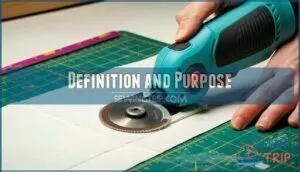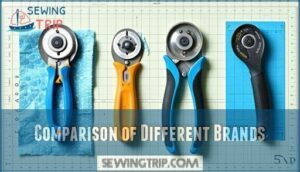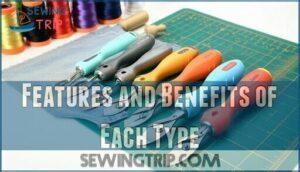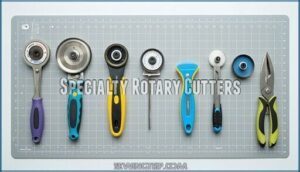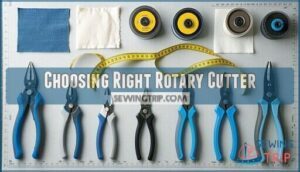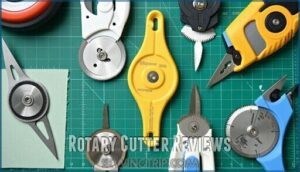This site is supported by our readers. We may earn a commission, at no cost to you, if you purchase through links.
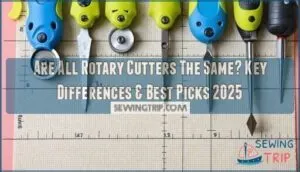
Budget models often produce ragged cuts and uncomfortable grips, while premium cutters offer smoother operation and better control. Blade quality varies dramatically between brands – some stay sharp for months, others dull after a few projects.
Handle shapes affect comfort during long cutting sessions, and safety features range from basic blade covers to automatic retraction systems. Professional quilters swear by certain brands for good reason.
The right cutter can transform your fabric cutting from a chore into smooth, precise work that makes every project shine.
Table Of Contents
Key Takeaways
- You’ll find significant differences in blade sizes (18mm-60mm), handle designs, and safety features that directly impact your cutting comfort and precision
- Budget models often produce ragged cuts and uncomfortable grips, while premium cutters offer smoother operation, better blade retention, and ergonomic handles that reduce hand fatigue
- Blade quality varies dramatically between brands—some stay sharp for months of regular use, while cheaper options dull after just a few projects, affecting both safety and cutting accuracy
- The right rotary cutter transforms fabric cutting from a frustrating chore into smooth, precise work, making proper selection based on your project needs and cutting frequency essential for quality results
Rotary Cutter Basics
When you’re shopping for rotary cutters, you’ll quickly discover they’re not all created equal.
Different brands offer varying blade sizes, handle designs, and safety features that can make or break your crafting experience.
Definition and Purpose
A rotary cutter is a circular-bladed fabric cutting tool that rolls along surfaces, making precise straight cuts through multiple fabric layers.
The precision tool that transforms fabric cutting from chore to craft.
Unlike traditional scissors, this crafting essential features a sharp rotating wheel that glides smoothly across quilting rulers and cutting mats.
You’ll find rotary cutters indispensable for quilting applications, allowing efficient fabric cutting with professional accuracy and speed.
Types of Rotary Cutters
You’ll find three main rotary cutter types on the market.
Standard rotary cutters handle most fabric cutting tasks with sizes ranging from 28mm to 65mm blades.
Ergonomic Cutters feature comfortable grips that reduce hand strain during extended use.
Mini Rotary cutters work perfectly for detailed cuts and curves.
Electric Cutters power through thick layers effortlessly.
Titanium coated blades offer enhanced durability.
Each rotary cutter size serves different fabric types and project needs, making them suitable for various tasks with enhanced durability and comfortable grips.
Importance of Rotary Cutters in Crafting
Professional crafters know that rotary cutters aren’t just fancy scissors.
These tools deliver Cutting Precision that hand scissors can’t match, slicing through multiple fabric layers with clean edges.
The Ergonomic Benefits reduce hand strain during long quilting sessions.
Project Versatility expands as you tackle curves, strips, and intricate shapes.
Time Savings multiply when batch cutting pieces.
Superior Material Handling means working with thick batting becomes manageable, transforming your crafting efficiency.
Are All Rotary Cutters Same
You might think all rotary cutters work the same way, but they’re actually quite different in design, comfort, and performance.
Each brand offers unique features like ergonomic handles, safety mechanisms, and blade systems that can make your cutting experience either smooth or frustrating.
Comparison of Different Brands
Major rotary cutter brands offer distinct advantages for different users.
Olfa pioneered the industry with tungsten steel blades lasting longer than standard alternatives. Fiskars leads ergonomic designs with SoftGrip handles reducing fatigue.
Clover delivers cutting precision favored by professional quilters through multi-stage blade honing. Martelli features patented ambidextrous handles perfect for left-handed crafters.
Dritz provides budget-friendly options at $8-12 per unit. Choosing between brands depends on whether precision or comfort is prioritized.
Features and Benefits of Each Type
Understanding rotary cutter types helps you pick the right tool for your projects.
Blade material affects sharpness retention—tungsten steel and titanium-coated options outlast standard carbon steel blades.
Handle ergonomics matter during long cutting sessions, with contoured grips reducing hand fatigue.
Safety features like retractable mechanisms prevent accidents, while cutting capacity varies by rotary cutter size.
Durability comparison shows premium models justify their cost through extended blade life and consistent performance across multiple fabric layers.
Specialty Rotary Cutters
Beyond standard cutters, specialty models serve specific tasks.
Ergonomic Rotary Cutters reduce hand strain during extended use. Mini Rotary Cutters handle tight curves and detailed work perfectly.
Wave Rotary Blades create decorative edges, while Pinking Rotary Cutters prevent fabric fraying. Bevel Rotary Cutters make precise angled cuts.
Each rotary cutter size offers unique advantages for different projects. Many users find reduced hand fatigue with specialized designs.
Choosing Right Rotary Cutter
Now that you know rotary cutters aren’t identical, you need to pick the right one for your projects.
Consider your hand size, cutting frequency, and fabric types to find your perfect match.
Size and Handle Options
Rotary cutter sizes range from 28mm to 65mm diameter.
Smaller cutters offer precision for detailed work, while larger ones cut multiple fabric layers efficiently.
Handle ergonomics matter – look for comfortable grip material and ambidextrous models.
The best rotary cutter combines proper cutter diameter with ergonomic design.
Consider your hand size and cutting style when selecting an ergonomic rotary cutter for quilting projects.
Many retailers offer a variety of rotary cutter options.
Blade Types and Uses
Different blade types transform your rotary cutter from basic tool to precision instrument. Blade Materials like tungsten steel last twice as long as standard options, while ceramic reduces friction. Blade Sizes matter too—18mm handles curves, 45mm tackles general quilting tasks, and 60mm powers through thick layers.
- Standard straight blades – Perfect for quilting rotary cutter work and general fabric cutting
- Pinking blades – Create zigzag edges that prevent fraying on seams
- Wave blades – Add decorative scalloped edges to craft projects
- Perforating blades – Make tear-lines in paper and interfacing materials
- Skip blades – Create spaced holes for specialty sewing techniques
Specialty Blades expand your rotary cutter uses beyond basic cuts. Consider Blade Safety features like retractable guards, especially with sharp titanium-coated options. To guarantee accurate cuts, remember the importance of non-slip rulers.
Regular Blade Sharpening or replacement keeps your rotary cutter blade performing at its best—dull blades increase accident risk and frustrate users.
Comparing Different Brands
In the context of Brand Performance, not all manufacturers deliver the same cutting experience.
Olfa rotary cutter models excel in Blade Longevity and precision, while Fiskars rotary cutter options offer superior Ergonomic Design for extended use.
Your quilting rotary cutter choice affects Cutting Accuracy substantially.
Price Comparison reveals budget-friendly rotary cutter quilting tools often sacrifice rotary cutter blade quality for affordability.
Rotary Cutter Accessories
You’ll need the right accessories to get the most from your rotary cutter and keep it working smoothly.
Essential add-ons include blade sharpeners, replacement blades, and cutting mats that protect your work surface while extending blade life.
These accessories, including cutting mats, are crucial for maintaining the effectiveness and longevity of your rotary cutter.
Robert Kaufman Multi Color Cotton Solids Fabric Card
When selecting fabric for your rotary cutter quilting projects, you’ll often find the Robert Kaufman Multi Color Cotton Solids Fabric Card invaluable for Coordinating Fabric Selection and Project Inspiration.
This extensive Fabric Card Uses reference tool offers:
- Color Palette Options spanning hundreds of coordinated solids
- Accurate fabric swatches for precise color matching
- Seasonal collections updated regularly for fresh inspiration
- Professional-grade cotton quality samples you can trust
- Portable format perfect for shopping trips and studio planning
The Kaufman Quality Review speaks for itself through consistent weave and colorfastness.
Quilted Bear Rotary Blade Sharpener
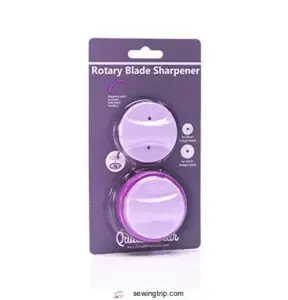
While fabric selection matters, keeping your rotary cutter sharp guarantees clean cuts every time.
The Quilted Bear Rotary Blade Sharpener offers an affordable solution for dull rotary cutter maintenance. This compact tool extends blade longevity through simple sharpening motions, improving rotary cutter safety and performance on rotary cutter fabric projects.
For larger projects, consider using a 60mm rotary cutter to improve efficiency.
| Feature | Details |
|---|---|
| Sharpener Effectiveness | Restores 80% of original blade sharpness |
| Cost Analysis | $15-20 vs $8-12 replacement blades |
| User Experiences | Mixed reviews on different blade brands |
| Sharpener Alternatives | Whetstones, replacement blades available |
| Maintenance Frequency | Every 10-15 hours of cutting time |
Rotary Cutter Reviews
When you’re ready to make your purchase, reading reviews from real users helps you understand how different rotary cutters perform in actual crafting situations.
These honest opinions reveal which models stay sharp longer, feel comfortable during extended cutting sessions, and deliver the precision you need for your projects.
Customer Feedback and Ratings
Customer reviews reveal telling patterns about rotary cutter performance.
Leading models like OLFA Ergonomic and Fiskars Comfort Loop consistently earn 4.6-4.7 star ratings from thousands of users.
Review sentiment highlights ergonomic benefits and rotary cutter safety features.
Brand reputation depends on rating accuracy and feedback authenticity.
Users frequently request better rotary cutter maintenance instructions and solutions for dull rotary cutter blades.
Using the correct blade size is essential, as larger blades cut more layers.
Pros and Cons of Popular Rotary Cutters
Olfa rotary cutters offer excellent cutting precision and ergonomic benefits, making all cutting tasks smoother.
Fiskars provides superior safety features and fabric compatibility across different materials.
However, these examples show varying sharpening rotary cutter needs and durability meanings.
Brand comparison reveals that while premium cutters cost more, they deliver better performance.
Budget options work fine for occasional use but may lack advanced features found in professional rotary cutter guide models.
Many users find helpful cutter comparisons useful.
Tips for Selecting The Best Rotary Cutter
When choosing your rotary cutter, consider blade material first – high-carbon steel stays sharp longest.
Handle ergonomics matter for extended usage, especially with arthritis. Look for safety features like blade guards and locking mechanisms.
Your cutting surface needs a selfhealing mat underneath. Budget considerations include replacement blade costs.
Read rotary cutter guide reviews before buying. Remember, regular sharpening rotary cutter maintenance keeps performance consistent. These simple phrases guide smart purchasing decisions.
Frequently Asked Questions (FAQs)
What kind of rotary cutter should I get?
Look for ergonomic handles, sharp blades, and safety features.
Consider 45mm for general use, 28mm for curves, 60mm for thick layers.
Quality brands like Olfa offer replaceable blades and comfortable grips.
What are the different types of rotary cutters?
You’ll find three main types: straight-handle cutters for basic cutting, ergonomic models with angled handles for comfort during extended use, and specialty cutters with interchangeable blades for different materials.
How often should rotary cutter blades be replaced?
You’ll need new blades when cutting becomes difficult or fraying occurs.
Heavy users replace them monthly, casual crafters every three to six months.
Dull blades damage fabric and strain your wrist unnecessarily, which can be avoided by replacing them regularly, especially for heavy users.
Can rotary cutters cut through multiple fabric layers?
Yes, rotary cutters can slice through multiple fabric layers simultaneously.
You’ll typically manage 4-8 layers of cotton or 2-4 layers of thicker materials like denim.
Sharp blades and steady pressure work best for clean cuts.
What safety precautions are needed when using rotary cutters?
Always use sharp blades, cut away from your body, and keep fingers clear of the cutting path.
Store with blade guards on, use cutting mats, and replace dull blades immediately for safer quilting.
How do you properly maintain and clean rotary cutters?
Clean regularly, replace blades promptly, and oil pivots consistently to keep your rotary cutter sharp, smooth, and ready for precise cuts every time.
Conclusion
Clearly, not all rotary cutters are created equal—unless you enjoy wrestling with dull blades that tear fabric like an angry toddler with safety scissors.
The differences between budget and premium models affect your cutting precision, comfort, and sanity.
Blade quality, handle ergonomics, and safety features vary substantially across brands.
Choose based on your project needs, cutting frequency, and budget.
The right rotary cutter transforms tedious fabric prep into smooth, accurate work that elevates every quilting or crafting project you tackle, ensuring a better overall quilting experience.
- https://docs.google.com/forms/d/1GAQr3Kn1cURCVHUA82hAga1Wv8DCH0IuqDLRUrOpN7M/viewform?ts=63f4f653&entry.1515682415=https://www.merriam-webster.com/dictionary%2Fall
- https://premium.britannica.com/mw-unabridged/?utm_source=mw&utm_medium=inline-def&utm_campaign=evergreen
- https://idioms.thefreedictionary.com/fit%2fready+to+drop
- https://es.thefreedictionary.com/vida
- https://en.wikipedia.org/wiki/English_language

